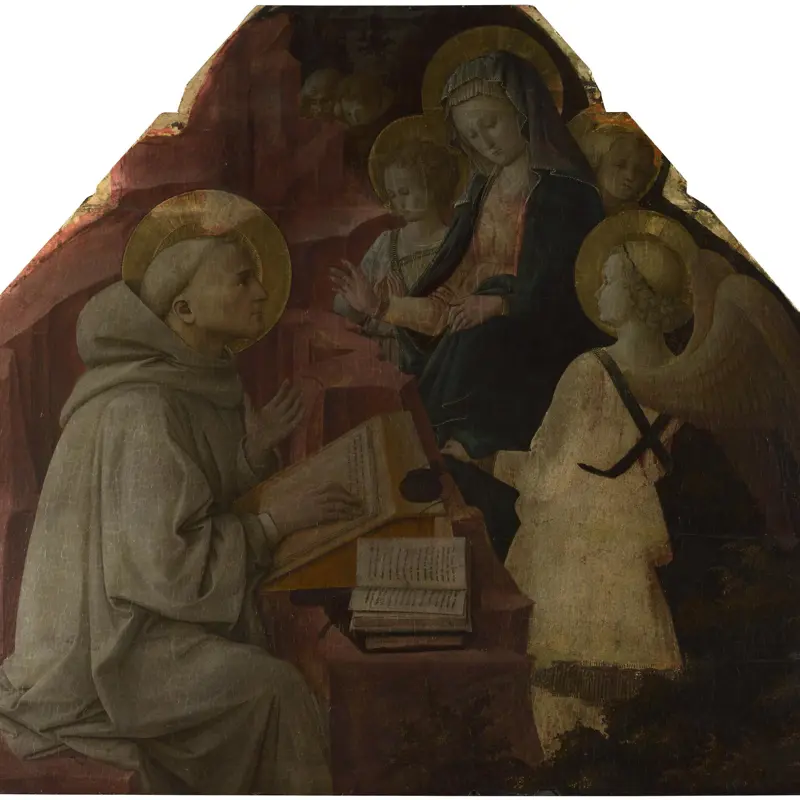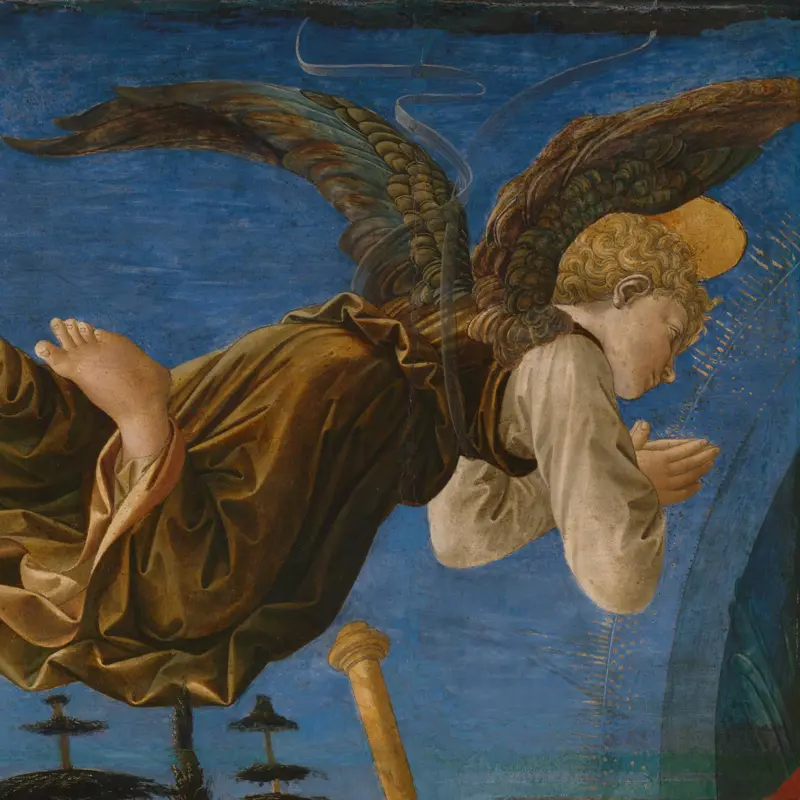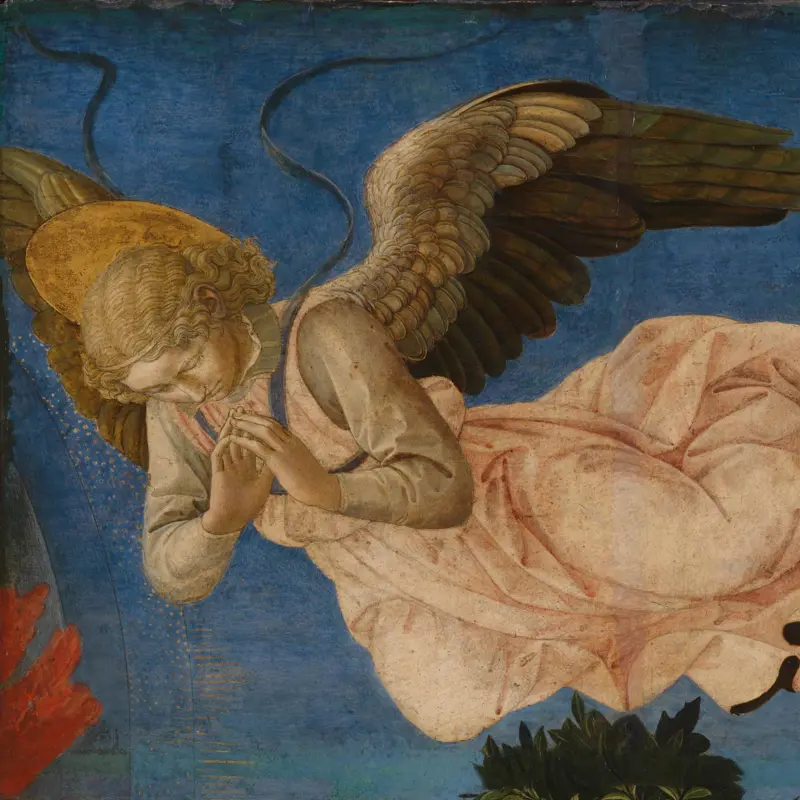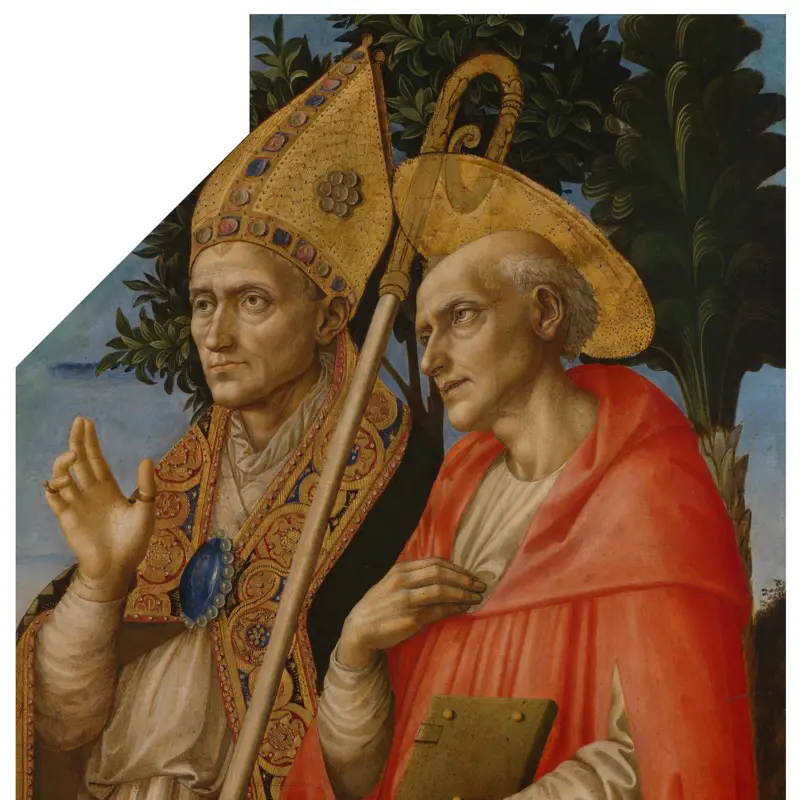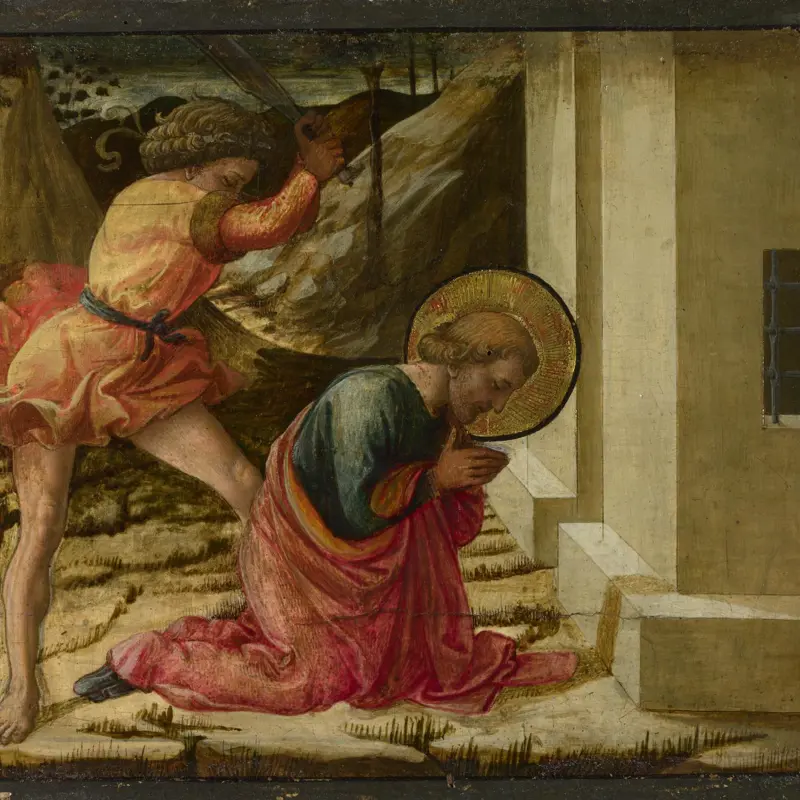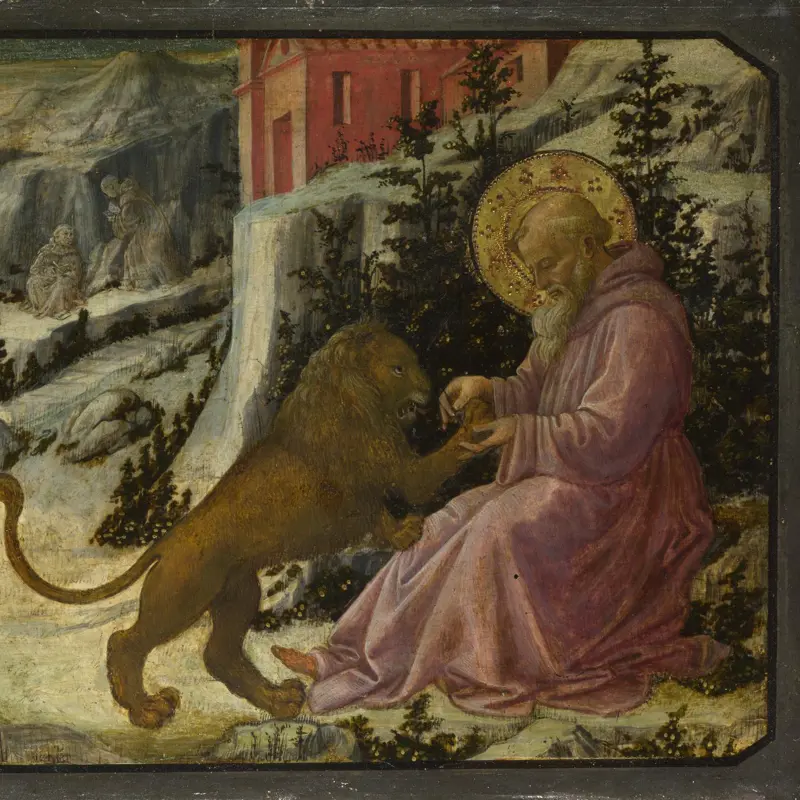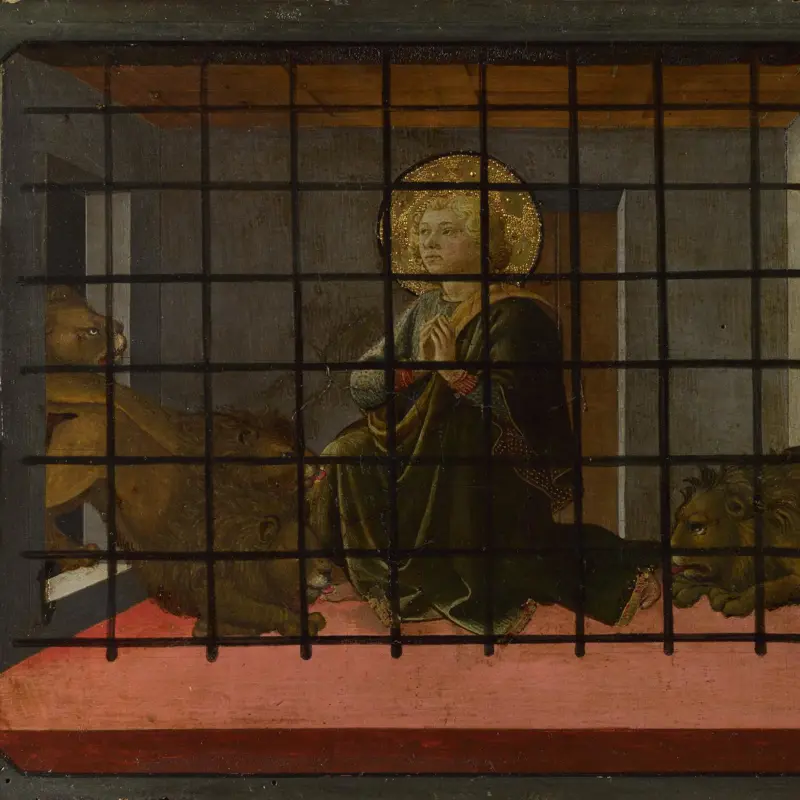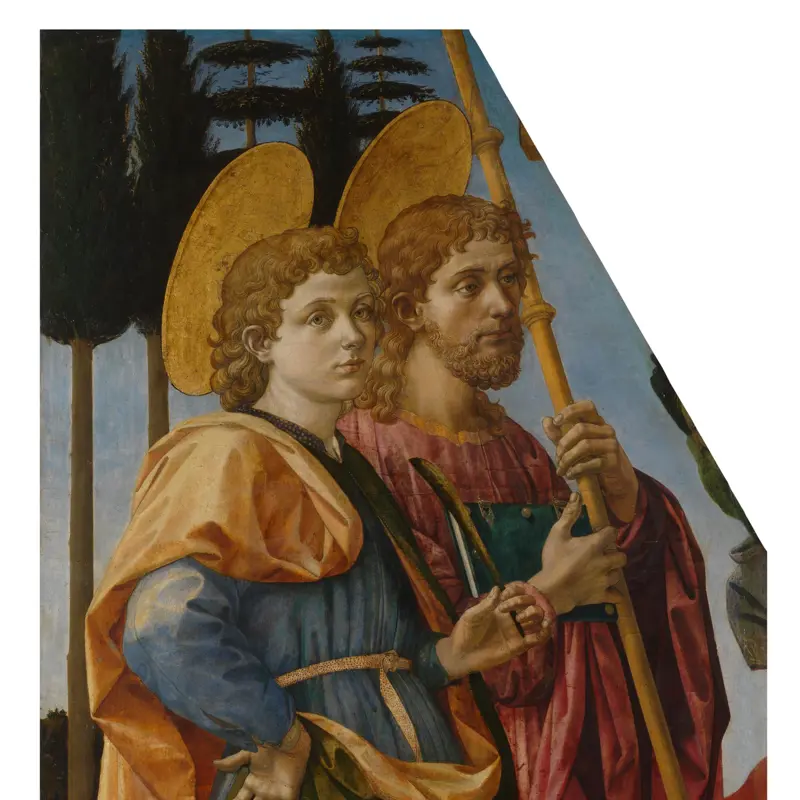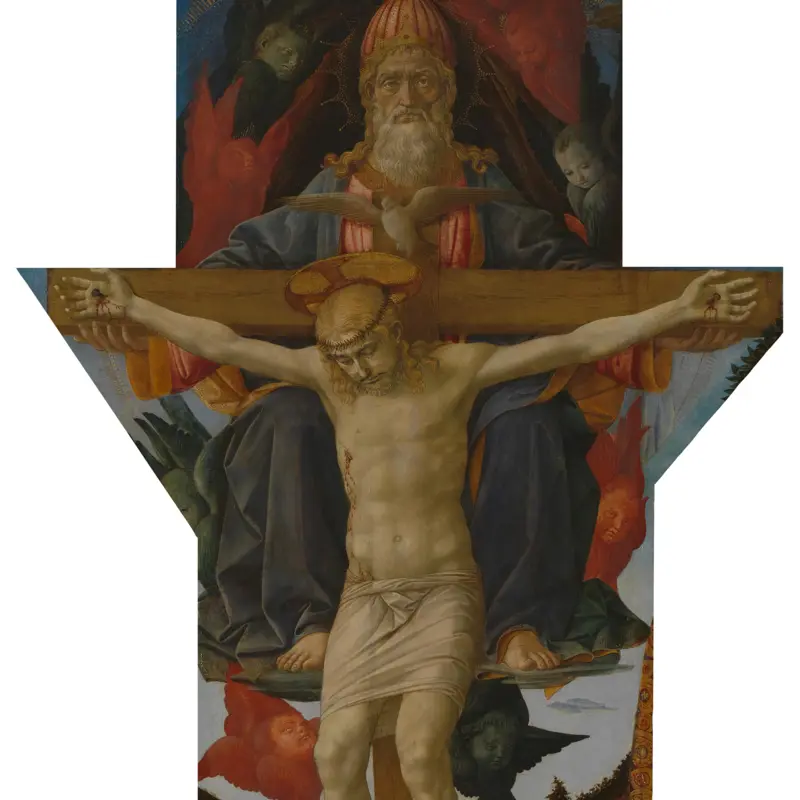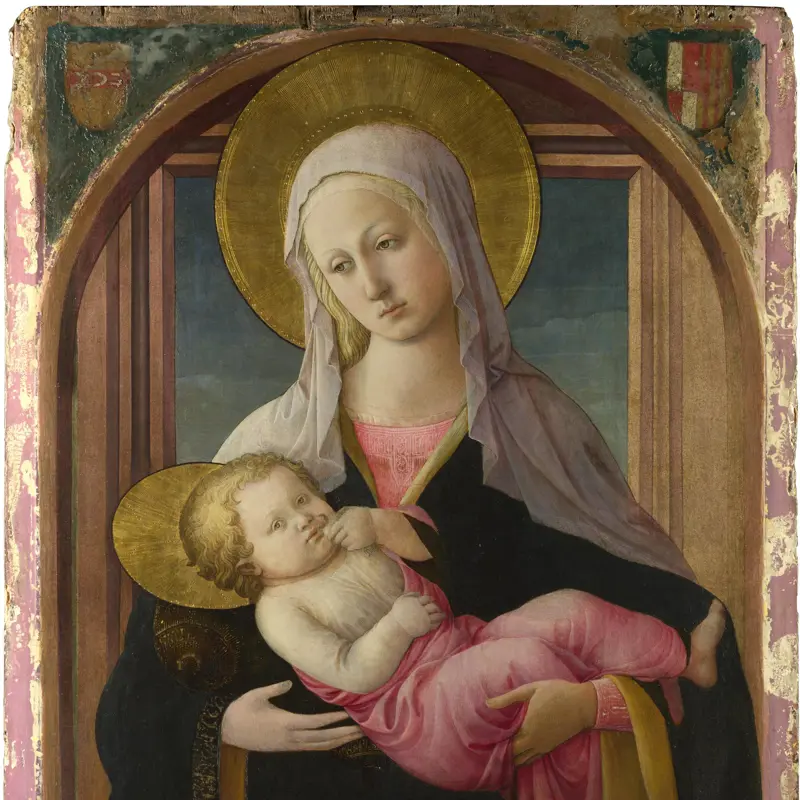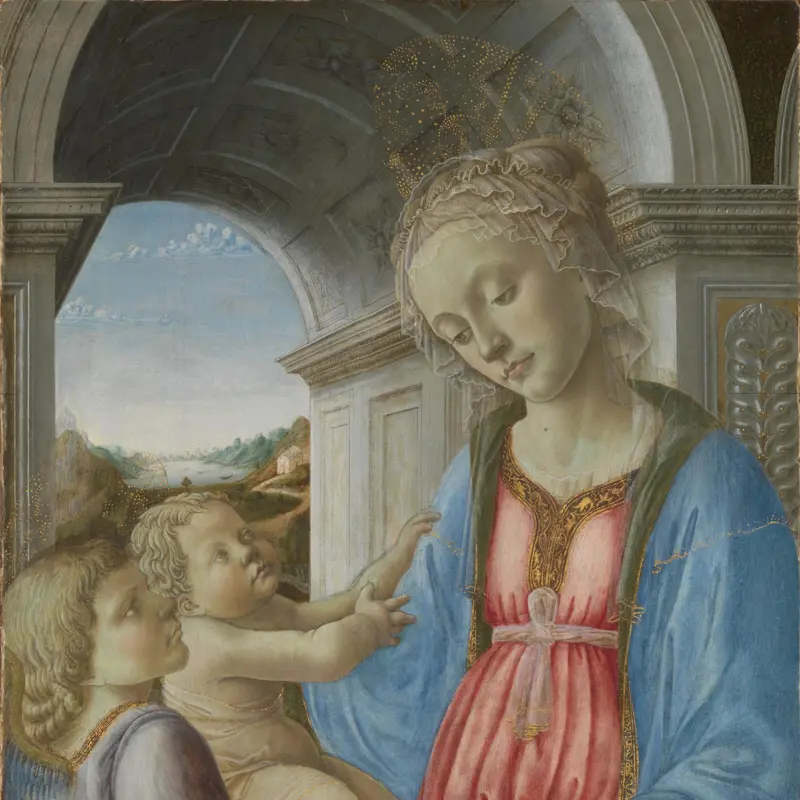Fra Filippo Lippi, 'The Annunciation', about 1450-3
About the work
Overview
The Archangel Gabriel, huge peacock-feather wings outstretched behind him, kneels in front of the Virgin Mary, his head bowed in reverence. He has arrived with the news that she will conceive a child, Jesus Christ, through the Holy Ghost.
A small dove, the symbol of the Holy Ghost, flies towards the Virgin’s belly: this is the moment of Christ’s conception. It has been sent by God, whose hand we can see appearing from a deep blue cloud that represents the heavens. A golden light emanates from a gap in Mary’s pink dress and she bows her head towards it, in acceptance.
This picture comes from a palace belonging to the Medici, Florence’s ruling family at the time, where it most probably hung above a door. It was made as a pair; the other panel, showing seven Medici patron saints, is also in the National Gallery’s collection.
Key facts
Details
- Full title
- The Annunciation
- Artist
- Fra Filippo Lippi
- Artist dates
- born about 1406; died 1469
- Part of the series
- Medici (Overdoor?) Panels
- Date made
- about 1450-3
- Medium and support
- egg tempera on wood
- Dimensions
- 68.6 × 152.7 cm
- Acquisition credit
- Presented by Sir Charles Eastlake, 1861
- Inventory number
- NG666
- Location
- Room 60
- Collection
- Main Collection
- Previous owners
- Frame
- 19th-century English Frame
Provenance
Additional information
Text extracted from the ‘Provenance’ section of the catalogue entry in Dillian Gordon, ‘National Gallery Catalogues: The Fifteenth Century Italian Paintings’, vol. 1, London 2003; for further information, see the full catalogue entry.
Bibliography
-
1846G. Vasari, Le vite de' più eccellenti pittori, scultori e architetti, ed. F. Le Monnier, 14 vols, Florence 1846
-
1857G.F. Waagen, Treasures of Art in Great Britain: Being and Account of the Chief Collections of Paintings, Drawings, Sculptures, Illuminated Mss. […], translated from German by Elizabeth Eastlake, 3 vols, London 1857, vol. 3
-
1858G. Scharf, Artistic and Descriptive Notes on the Most remarkable Pictures in the British Institution Exhibition of the Ancient Masters, London 1858
-
1878G. Vasari, Le vite de'più eccellenti pittori, scultori ed architettori: Con nuove annotazioni e commenti di Gaetano Milanesi, ed. G. Milanesi, 8 vols, Florence 1878
-
1902I.B. Supino, Fra Filippo Lippi, Florence 1902
-
1903J.A. Crowe and G.B. Cavalcaselle, A History of Painting in Italy, Umbria, Florence and Siena, from the Second to the Sixteenth Century, ed. R.L. Douglas, 2nd edn, 6 vols, London 1903
-
1909H. Mendelsohn, Fra Filippo Lippi, Florence 1909
-
1923R. van Marle, The Development of the Italian Schools of Painting, 19 vols, The Hague 1923
-
1932B. Berenson, 'Fra Angelico, Fra Filippo e la cronologia', Bollettino d'arte, XXVI, 1932, pp. 1-22, 49-66
-
1932A. Warburg, 'Delle "Imprese Amorose" nelle più antiche incisioni, 1905', in A. Warburg, Gesammelte Schriften, Leipzig 1932, vol. 1, pp. 77-88
-
1936G. Pudelko, 'Per la datazione delle opere di Fra Filippo Lippi', Rivista d'arte, 1936, pp. 45-76
-
1942R. Oertel, Fra Filippo Lippi, Vienna 1942
-
1949M. Pittaluga, Filippo Lippi, Florence 1949
-
1950M. Davies, 'Fra Filippo Lippi's Annunciation and Seven Saints', Critica d'arte, XXXI, 1950, pp. 356-63
-
1951Davies, Martin, National Gallery Catalogues: The Earlier Italian Schools, London 1951
-
1953G. Robertson, 'Review of Martin Davies "Earlier Italian Schools"', The Burlington Magazine, 1953
-
1961M. Davies, The Earlier Italian Schools, 2nd edn, London 1961
-
1975G. Marchini, Filippo Lippi, Milan 1975
-
1979F. Ames-Lewis, 'Early Medicean Devices', Journal of the Warburg and Courtauld Institutes, XLII, 1979, pp. 122-43
-
1986Davies, Martin, National Gallery Catalogues: The Earlier Italian Schools, revised edn, London 1986
-
1987S.Y. Edgerton, '"How Shall This Be?", Reflections on Filippo Lippi's Annunciation in London, Part II', Artibus et historiae, XVI, 1987, pp. 45-53
-
1987L. Steinberg, '"How Shall This Be?", Reflections on Filippo Lippi's Annunciation in London, Part I', Artibus et historiae, XVI, 1987, pp. 25-44
-
1988M.A. Pavone, Iconologia francescana: Il Quattrocento, Todi 1988
-
1989E.W. Rowlands, 'Filippo Lippi and His Experience of Painting in the Veneto Region', Artibus et historiae, 19, 1989, pp. 53-83
-
1990M. Bailey, 'And so to Bedsteads … Mystery of the Renaissance Pictures may Now be Solved', The Observer, 1990
-
1990Spink & Son, Costume and Textiles at Spink, London, 5 December 1990 - 20 December 1990
-
1990J. Turner, 'The Bed Instead', Art News, 1990
-
1991J. Dunkerton et al., Giotto to Dürer: Early Renaissance Painting in the National Gallery, New Haven 1991
-
1991S.Y. Edgerton, 'Geometrization of the Supernatural: Fra Filippo Lippi's London Annunciation', in S.Y. Edgerton, The Heritage of Giotto's Geometry: Art and Science on the Eve of the Scientific Revolution, Ithaca 1991, pp. 88-107
-
1993J. Ruda, Fra Filippo Lippi: Life and Work with a Complete Catalogue, London 1993
-
1993Spencer's, Presents for Christmas, Retford, 21 November 1993
-
1993F. Ames-Lewis, 'Art in the Service of the Family: The Taste and Patronage of Piero de Cosimo de' Medici', in A. Beyer and B. Boucher (eds), Piero de'Medici 'il Gottoso' (1416-1469), Kunst im Dienste der Mediceer: Acts of a Conference held in Bad Homburg, 1991, Berlin 1993, pp. 207-20
-
1995M. Boskovits, 'Attorno al tondo Cook: Precisiazione sul Beato Angelico su Filippo Lippi e altri', Mitteilungen des Kunsthistorischen Institutes in Florenz, I, 1995, pp. 32-67
-
1996E.R. Knauer, 'Oculus und Maria Verkündigung. Eine Nachlese', in V. von Flemming and S. Schütze (eds), Ars naturam adiuvans. Festschrift für Matthias Winner, Mainz 1996, pp. 75ff
-
1997M.P. Mannini and M. Fagioli, Filippo Lippi: Catalogo completo, Florence 1997
-
1997National Gallery, 'Joanna Trollope's Picture Choice', National Gallery News, 1997
-
1999L. Apfelbaum, L'annonciation dans tous ses états, Paris 1999
-
1999D. Arasse, L'annonciation italienne: Une histoire de perspective, Paris 1999
-
1999M. Holmes, Fra Filippo Lippi: The Carmelite Painter, New Haven 1999
-
2001
C. Baker and T. Henry, The National Gallery: Complete Illustrated Catalogue, London 2001
-
2003Gordon, Dillian, National Gallery Catalogues: The Fifteenth Century Italian Paintings, 1, London 2003
Frame
Crafted from pinewood, the inner moulding was made in England in the nineteenth century, while the outer frame dates to the twentieth century. The panel is arch-shaped and framed in a landscape format, accommodating the curvature with ornate spandrels set in a gilt architectural moulding. These spandrels boast engraved laurel wreaths bound with ribbon against a backdrop of gold punch-tooling.
In the nineteenth century, Lippi’s The Annunciation and its frame were placed within a rosewood glass case for protection. In 1922 both the frame and its accompanying glass case underwent repairs. By 1931 the rosewood case was replaced, and the frame was converted to have a glass door fitted.
About this record
If you know more about this work or have spotted an error, please contact us. Please note that exhibition histories are listed from 2009 onwards. Bibliographies may not be complete; more comprehensive information is available in the National Gallery Library.
Images
About the series: Medici (Overdoor?) Panels
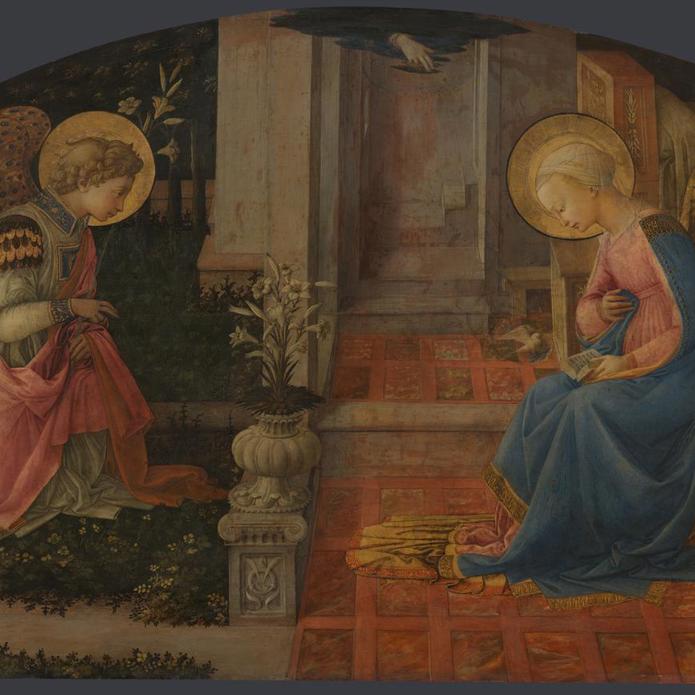
Overview
These panels were made for a member of Florence’s ruling family, the Medici, and once hung in the Palazzo Medici. One panel shows the Annunciation (when the Virgin Mary was told she would conceive a son, Jesus Christ); the other, a gathering of patron saints of the Medici family. The panels are similar in size, scale and viewpoint, suggesting that they were designed as a pair, and were intended to hang where they could be viewed together.
They may have been placed over the doors of Piero de' Medici’s study – its ceiling was decorated with ceramic roundels representing the signs of the zodiac (and, therefore, the months). The Annunciation suits such a setting: its feast was celebrated on 25 March, the first day of the Florentine calendar year. Depicting Medici patron saints may have been a way to demonstrate the protection they offered to the city throughout the year.



